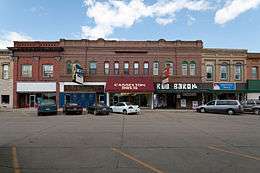Haxby & Gillespie
Haxby & Gillespie was an architectural firm from Fargo, North Dakota. R. J. Haxby and William D. Gillespie were the partners.[1] The firm "produced a number of important buildings throughout North Dakota." They designed many notable public, educational, commercial, and church buildings, in North Dakota, Minnesota, and Montana.[1]

History
Prior to coming to Fargo, R. J. Haxby was a practicing architect in New York City and Superior, Wisconsin. He moved to Fargo late in 1905 after a young architect, William D. Gillespie, advertised for a business partner to take over the practice of his recently deceased brother-in-law, William C. Albrant.[2]
In early 1906 Haxby and Gillespie reorganized Albrant's firm as R. J. Haxby & Company.[3] In September 1906 the firm was renamed Haxby & Gillespie.[4] They remained together until 1916, when Gillespie established his own office.[5] Haxby's firm became Haxby & Braseth, which it remained until the end of 1917, as Haxby had died in August.[3] It was succeeded by Braseth & Rosatti.[6]
Gillespie later retired from architecture and founded a bank, the Gate City Savings and Loan, which became prominent in the state.[5]
R. J. Haxby's son, Robert V. L. Haxby, was an architect in Minneapolis, where he was a partner in the firms of Stebbins & Haxby, Stebbins, Haxby & Bissell, and Haxby & Bissell. He was appointed Minneapolis' school board architect in 1915.[7]
A number of the firm's works are listed on the National Register of Historic Places.[8]
Architectural Works
R. J. Haxby & Company, 1906
- 1906 - Farmers' and Merchants' National Bank Building, 102 8th St. N., New Rockford, North Dakota.[9]
- 1906 - Minot M. E. Church, 2 2nd Ave. SE, Minot, North Dakota. Demolished.[10]
Haxby & Gillespie, 1906-1916
- 1907 - Fargo Armory, 78 Broadway N., Fargo, North Dakota. Demolished.[11]
- 1907 - Port Block, 626 Front St., Casselton, North Dakota.[12]
- 1907 - Ross Public School, Central Ave., Ross, North Dakota.[13]
- 1907 - Sentinel Butte Public School, Byron St., Sentinel Butte, North Dakota. Demolished.
- 1908 - Carrington High School, off U.S. 281, Carrington, North Dakota. Demolished 2008.
- 1908 - Glen Ullin High School, 206 S. 2nd St., Glen Ullin, North Dakota. Demolished 1981.[14]
- 1909 - Carnegie Public Library, 426 Bemidji Ave., Bemidji, Minnesota.
- 1909 - Hebron High School, 400 Church St., Hebron, North Dakota. Demolished.[15]
- 1909 - Ramsey County Jail, 420 6th St., Devils Lake, North Dakota.
- 1909 - Van Es Hall, North Dakota State University, Fargo, North Dakota. Demolished.[16]
- 1910 - Hotel Evelyn, 224 3rd St. E., Thief River Falls, Minnesota. Demolished.[17]
- 1910 - Ladd Hall, North Dakota State University, Fargo, North Dakota.[18]
- 1910 - Valley City City Hall, 216 2nd Ave. NE, Valley City, North Dakota. Demolished.[19]
- 1910 - Wahpeton Armory, 421 E. Cecil Ave., Wahpeton, North Dakota.[20]
- 1912 - Old Main, Minot State University, Minot, North Dakota.[21]
- 1913 - Bowdon High School, 319 Warrington Ave., Bowdon, North Dakota.[22]
- 1913 - Hope City Hall, 107 Steele Ave., Hope, North Dakota.[23]
- 1913 - Pioneer Hall, Minot State University, Minot, North Dakota.[24]
- 1913 - Sykeston High School, 114 B St. NE, Sykeston, North Dakota.[25]
- 1913 - Walsh County Agricultural School, 605 6th St. W., Park River, North Dakota. Demolished.[26]
- 1914 - A. O. U. W. Building, 112-114 N. Roberts St., Fargo, North Dakota.
- 1914 - Lowman Block, 406-410 Broadway N., Fargo, North Dakota.[27]
- 1915 - Wolf Point Public School, Wolf Point, Montana. Demolished.[28]
Haxby & Braseth, 1916-1917
- 1916 - Mayville High School, Mayville, North Dakota. Demolished.[29]
- 1917 - Woodrow Wilson School, 315 N. University Dr., Fargo, North Dakota.[30]
Gallery
 Port Block, Casselton, 1907.
Port Block, Casselton, 1907.
 A. O. U. M. Building, Fargo, 1914.
A. O. U. M. Building, Fargo, 1914.
References
- Jackie Sluss (February 26, 1980). "National Register of Historic Places Registration: Lincoln Building". and accompanying six photos from 1903 and 1979
- Martens, Steve C. and Ronald H. L. M. Ramsay. Buildings of North Dakota. 2015.
- "Former Superior Man is Called in Fargo". Duluth (MN) Herald Aug. 29 1917.
- School Board Journal Sept. 1906: 27.
- Ronald Lanier Ramsey (February 10, 1979). "National Register of Historic Places Inventory-Nomination: Grand Lodge of North Dakota, Ancient Order of United Workmen". National Park Service. and Accompanying six photos, exterior and interior, from 1979
- American Contractor 19 Jan. 1918: 60.
- American Stone Trade 1 July 1915: 29. Chicago.
- "National Register Information System". National Register of Historic Places. National Park Service. July 9, 2010.
- Improvement Bulletin 5 May 1906: 27.
- Improvement Bulletin 19 May 1906: 21.
- Engineering World 7 Dec. 1906: 839.
- Improvement Bulletin 27 April 1907: 20.
- Improvement Bulletin 2 Feb. 1907: 27.
- Municipal Journal and Engineer 22 April 1908: 507.
- School Board Journal Sept. 1909: 29.
- Engineering Record 29 May 1909: 50b.
- Improvement Bulletin 5 March 1910: 45.
- Improvement Bulletin 7 May 1910: 48.
- Municipal Journal 16 March 1910: 420.
- Improvement Bulletin 23 April 1910: 29.
- American Architect 21 Aug. 1912: 14.
- Engineering Record 31 May 1913: 50.
- Western Contractor 5 March 1913: 15.
- Western Contractor 12 Feb. 1913: 28.
- Engineering Record 26 April 1913: 54.
- Engineering Record 28 June 1913: 54.
- Look Around Downtown: Fargo Heritage Discovery Walk. 2007.
- American Contractor 26 June 1915: 81.
- Engineering News 21 Sept. 1916: 144.
- American Contractor 22 Sept. 1917: 53.